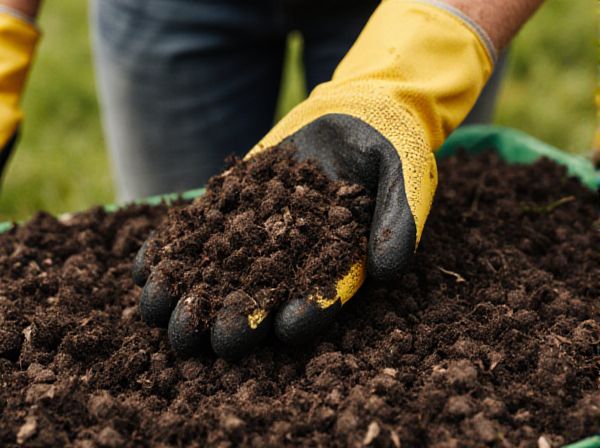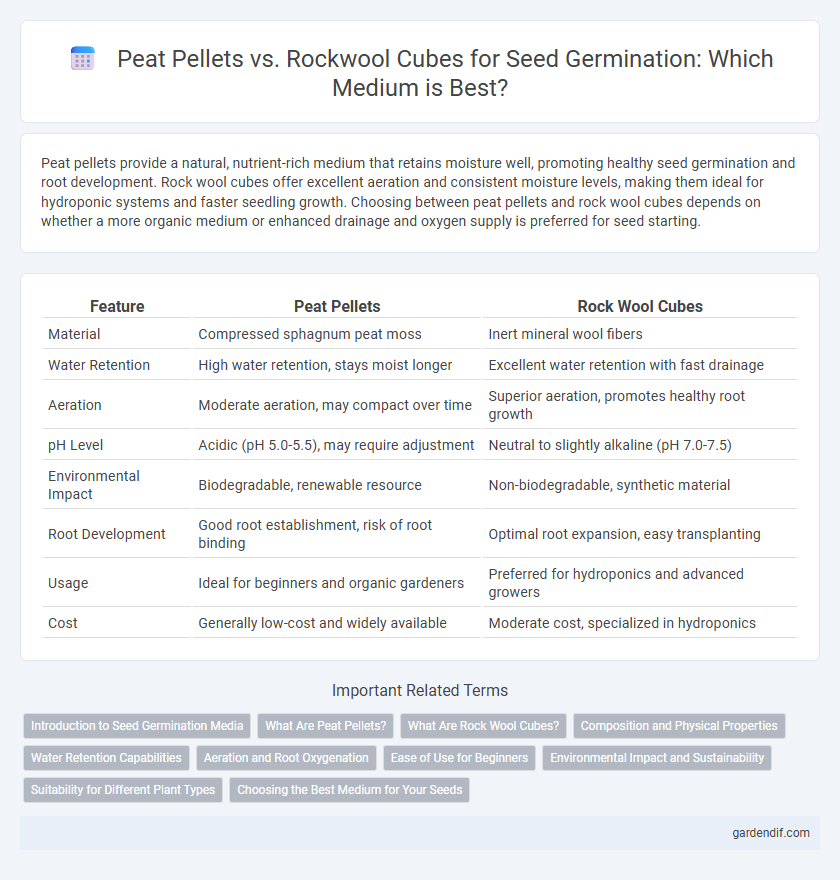
Peat Pellets vs Rock Wool Cubes Illustration
Peat pellets provide a natural, nutrient-rich medium that retains moisture well, promoting healthy seed germination and root development. Rock wool cubes offer excellent aeration and consistent moisture levels, making them ideal for hydroponic systems and faster seedling growth. Choosing between peat pellets and rock wool cubes depends on whether a more organic medium or enhanced drainage and oxygen supply is preferred for seed starting.
Table of Comparison
| Feature | Peat Pellets | Rock Wool Cubes |
|---|---|---|
| Material | Compressed sphagnum peat moss | Inert mineral wool fibers |
| Water Retention | High water retention, stays moist longer | Excellent water retention with fast drainage |
| Aeration | Moderate aeration, may compact over time | Superior aeration, promotes healthy root growth |
| pH Level | Acidic (pH 5.0-5.5), may require adjustment | Neutral to slightly alkaline (pH 7.0-7.5) |
| Environmental Impact | Biodegradable, renewable resource | Non-biodegradable, synthetic material |
| Root Development | Good root establishment, risk of root binding | Optimal root expansion, easy transplanting |
| Usage | Ideal for beginners and organic gardeners | Preferred for hydroponics and advanced growers |
| Cost | Generally low-cost and widely available | Moderate cost, specialized in hydroponics |
Introduction to Seed Germination Media
Peat pellets and rock wool cubes serve as popular seed germination media, each offering distinct advantages for optimal seedling development. Peat pellets are organic, biodegradable, and provide excellent moisture retention and aeration, fostering healthy root growth. Rock wool cubes, made from spun volcanic rock, offer superior water retention and consistent aeration but require careful pH management to prevent seedling stress.
What Are Peat Pellets?
Peat pellets are small, compressed disks of sphagnum peat moss designed for seed germination and root development. When hydrated, these pellets expand to form a nutrient-rich, aerated medium that promotes healthy seedling growth without the need for transplant shock. Compared to rock wool cubes, peat pellets offer an organic, biodegradable option favored for their natural moisture retention and ease of handling.
What Are Rock Wool Cubes?
Rock wool cubes are inert growing mediums made from spun molten rock fibers, providing excellent aeration and water retention for seed germination. Their porous structure promotes robust root development by maintaining a balanced moisture environment while preventing overwatering. Commonly used in hydroponic systems, rock wool cubes offer a sterile, reusable alternative to organic substrates like peat pellets.
Composition and Physical Properties
Peat pellets consist of compressed sphagnum peat moss, offering excellent water retention, aeration, and organic nutrients beneficial for seed germination. Rock wool cubes are made from spun molten basalt rock fibers, providing superior drainage, structural stability, and pH neutrality but lack inherent nutrients. The fibrous texture of rock wool promotes root oxygenation, whereas peat pellets' dense composition retains moisture longer, influencing seedling growth dynamics.
Water Retention Capabilities
Peat pellets have superior water retention capabilities due to their organic composition, which allows them to absorb and hold moisture effectively, providing a consistent hydration environment for seed germination. Rock wool cubes offer excellent water retention as well but tend to drain faster, requiring more frequent watering to maintain optimal moisture levels. Choosing peat pellets ensures prolonged moisture availability, which can enhance seedling development during the early germination stages.
Aeration and Root Oxygenation
Peat pellets offer superior aeration and root oxygenation due to their natural fibrous structure that promotes air flow and water retention simultaneously. Rock wool cubes provide consistent moisture levels but can restrict oxygen availability if overwatered, potentially hindering root respiration. Optimal germination requires balancing moisture and aeration, with peat pellets favoring oxygen-rich environments essential for healthy root development.
Ease of Use for Beginners
Peat pellets offer exceptional ease of use for beginners due to their compact, self-contained design that requires minimal preparation and mess, making seed starting straightforward. Rock wool cubes demand careful handling because of their delicate fibers and often require presoaking and pH adjustments, which can be challenging for novices. For beginners seeking simplicity and hassle-free germination, peat pellets provide a more user-friendly option with fewer steps and less maintenance.
Environmental Impact and Sustainability
Peat pellets contribute to environmental degradation due to peatland destruction, releasing significant carbon dioxide and reducing biodiversity, whereas rock wool cubes, made from volcanic rock and recycled materials, offer a more sustainable alternative with minimal ecological footprint. Peat extraction disrupts natural habitats and depletes non-renewable resources, while rock wool production consumes less energy and supports recycling efforts. Choosing rock wool cubes over peat pellets aligns with sustainable gardening practices by minimizing carbon emissions and conserving critical ecosystems.
Suitability for Different Plant Types
Peat pellets are ideal for seed starting of herbs, flowers, and vegetables that prefer acidic, well-drained conditions, while rock wool cubes suit hydroponic systems and plants requiring consistent moisture and aeration, such as lettuce and tomatoes. Peat pellets naturally retain moisture and nutrients, supporting root development for a wide range of terrestrial plants. Rock wool cubes provide a sterile, pH-neutral medium favored in commercial propagation and plants sensitive to pH fluctuations.
Choosing the Best Medium for Your Seeds
Peat pellets offer excellent moisture retention and natural nutrients, creating an ideal environment for seed germination. Rock wool cubes provide superior aeration and consistent pH levels, promoting strong root development in hydroponic systems. Selecting the best medium depends on your specific growing conditions, with peat pellets favored for soil-based starts and rock wool preferred for hydroponic or controlled environments.
Peat Pellets vs Rock Wool Cubes Infographic

 gardendif.com
gardendif.com